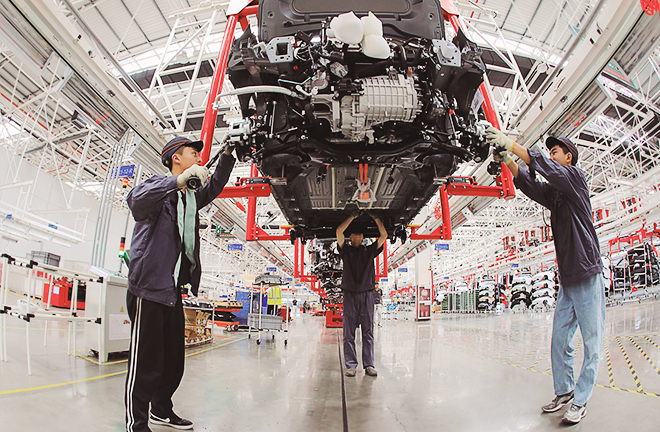Digital economy matches new quality productive forces

Electric vehicle Photo: CNS
The concept of new quality productive forces, originally proposed by General Secretary of the CPC Central Committee Xi Jinping, can be understood and analyzed from four aspects: industrial orientation, driving-force mechanisms, organizational models, and development outcomes. In terms of industrial orientation, strategic emerging industries including new energy, new materials, advanced manufacturing, electronic information, as well as future industries including Artificial General Intelligence (AGI), fall within the scope of new quality productive forces. Regarding driving-force mechanisms, the revolutionary breakthroughs in these frontier areas and industrial directions included in new quality productive forces, are all spurred by disruptive technological innovation. As for organizational modes, new quality productive forces generated out of technological revolutions will not only lead to various new products, services, and even industries, but will also result in the restructuring of production and operation modes. Lastly, in terms of development outcomes, as an advanced form of productive forces, new quality productive forces will inevitably manifest characteristics of advanced technology, high efficacy, and high quality, ultimately leading to a remarkable rise in total factor productivity.
The digital economy closely aligns with new quality productive forces in the aforementioned four aspects. As for industrial orientation, the new generation of information technologies represented by big data is not only an important part of the digital economy, but also the material technological basis for various new modes and business formats of digital economy operations. In terms of driving-force mechanisms, the new generation of information technologies represents revolutionary breakthroughs in the field of information communication, representing the frontier of a new round of scientific and industrial transformation. As for organizational forms, the comprehensive and revolutionary progress of information communication technologies can significantly reduce the cost of data processing, transforming data into a new productive factor. In terms of development outcomes, the widespread use of data factors facilitates smoother connections between various aspects of socioeconomic operations, leading to a broad improvement in production efficiency and ultimately manifesting as an increase in total productivity and high-quality economic development. The alignment of these four aspects underscores the digital economy’s rightful place as the primary battlefield for the development of new quality productive forces. Moreover, promoting the healthy development of the digital economy should be the focal point for advancing new quality productive forces.
With the organic combination of strong political advantages, institutional advantages and, the advantage of a super-large scale market, China’s digital economy has made remarkable achievements. In the corporate sector, China has seen the emergence of several globally influential internet technology companies.
Of course, amidst the complex and fierce international competitive environment, China’s digital economy also faces numerous real challenges. Firstly, the unresolved issue of key core technology stranglehold remains a challenge. Secondly, there is an urgent need to accelerate the improvement of relevant basic institutional mechanisms to better leverage the role of data factors. Finally, the accelerated evolution of Artificial intelligence Generated Content (AIGC) and AGI since 2022 is reshaping the global technological and industrial competitive landscapes. On one hand, the huge demand for computing power brought by the accelerated commercial application of AIGC and AGI will lead to the accelerated growth of upstream computing chips and data-related industries, and will also strengthen the industrial technological advantages of first-mover enterprises and their countries. On the other hand, industry-specific large models generated by (open-source) AIGC, trained with vertical domain knowledge, are exerting disruptive impacts on an increasing number of industries, fundamentally changing industrial organizational models and competitive landscapes. In addition, the AGI technology is improving the efficiency of research and development (R&D) in many fields such as biomedicine and new materials in unprecedented ways, accelerating technological progress and expanding the technological leadership advantages of relevant countries.
To effectively leverage the role of the digital economy as the primary battlefield for the development of new quality productive forces, we must start from the aspects of strategic layout and system construction, and actively respond to the aforementioned challenges. First, in terms of key core technologies, it is essential to capitalize on existing (relative) advantages and to cultivate strengths. Second, it is suggested to accelerate the introduction of relevant systems centered on data transactions, public data development, and cross-border data flow to consolidate the foundation for the development of the digital economy. Third, it is advised to focus on improving the R&D capabilities and application levels of AI technology, reinforcing the position of enterprises as leaders in sci-tech innovation. Mechanism innovations should be accelerated, particularly in attracting top talent and enhancing model applications, aiming to build an AI innovation ecology involving industry-university-research collaboration.
Cai Yuezhou is a research fellow from the Institute of Quantitative & Technological Economics at the Chinese Academy of Social Sciences.
Edited by ZHAO YUAN
